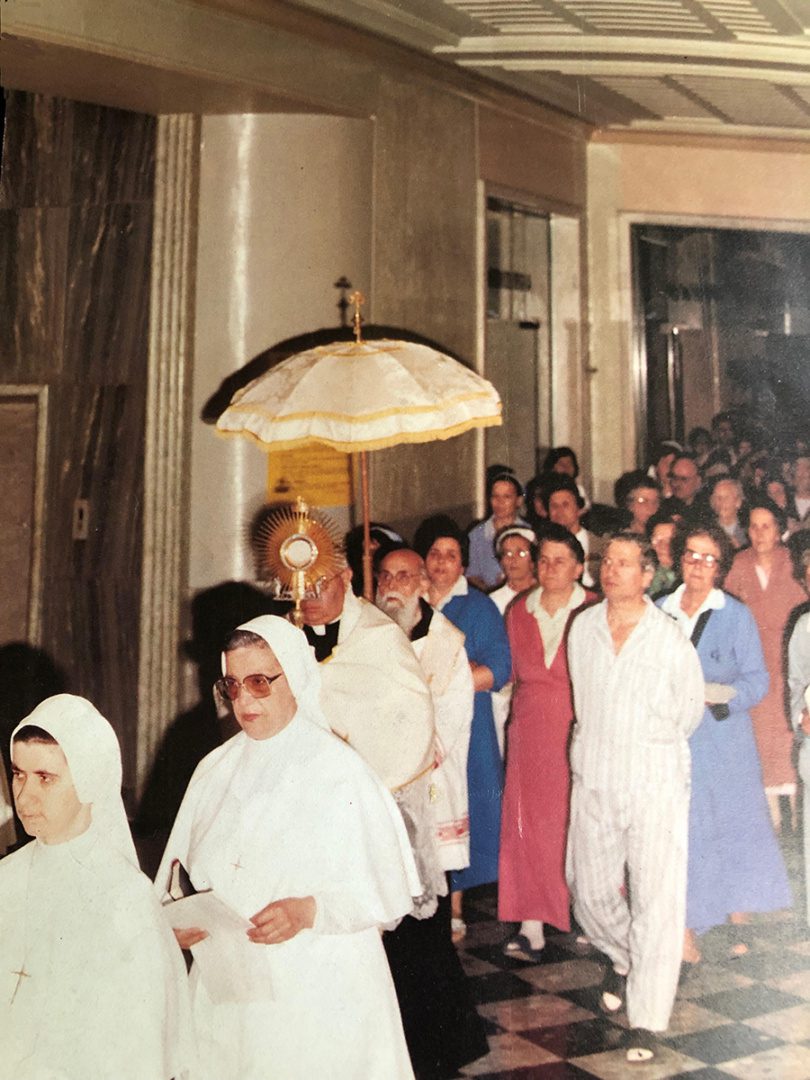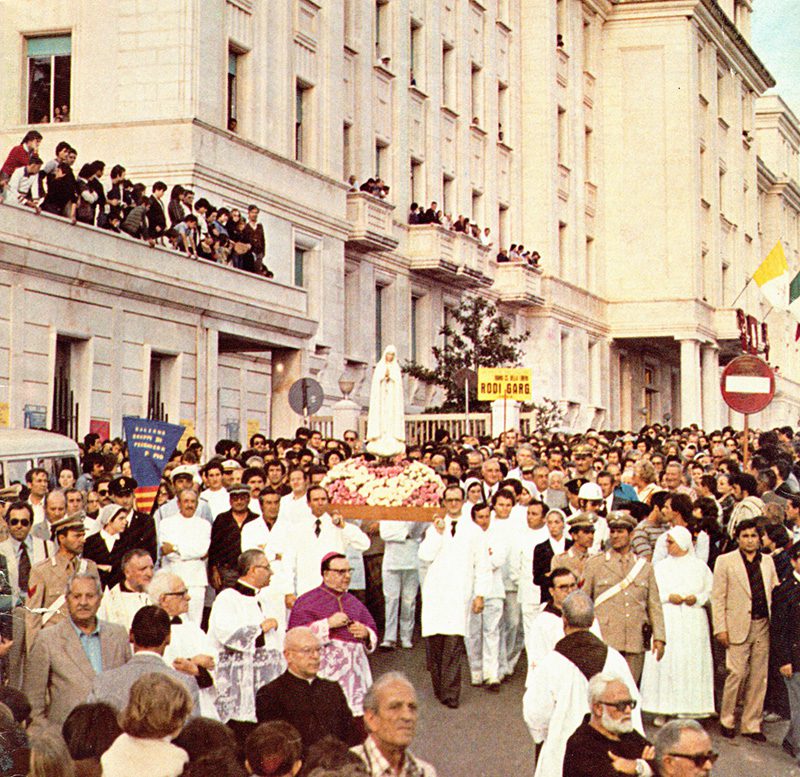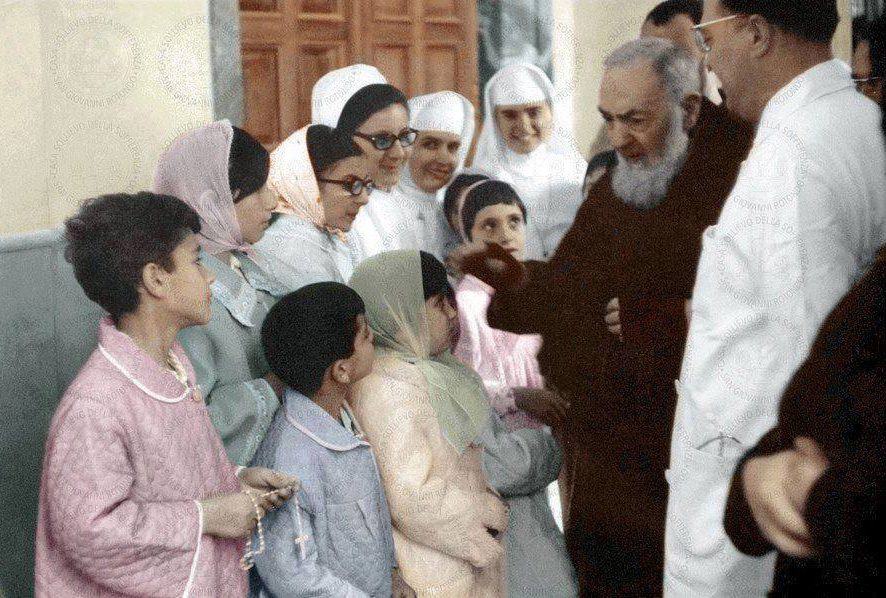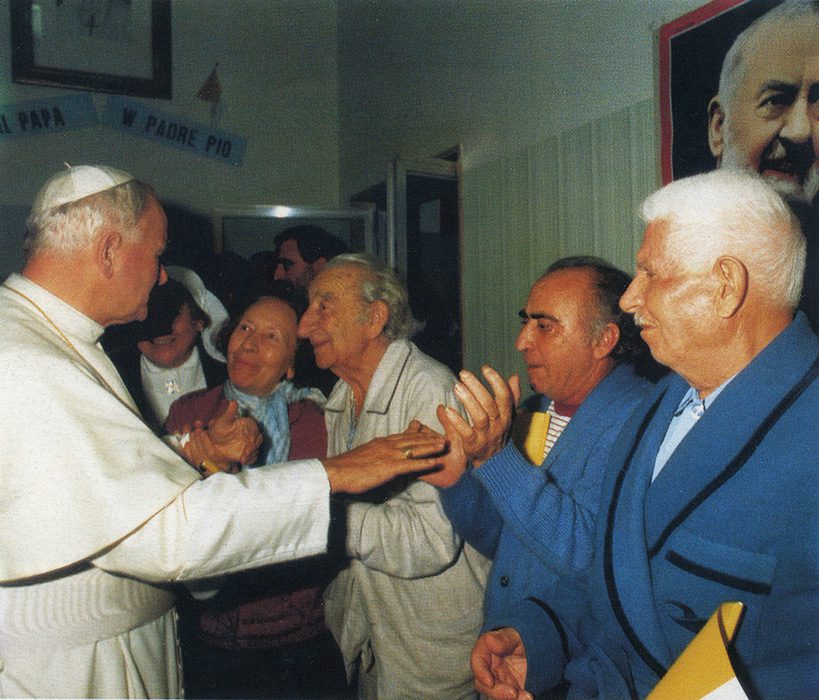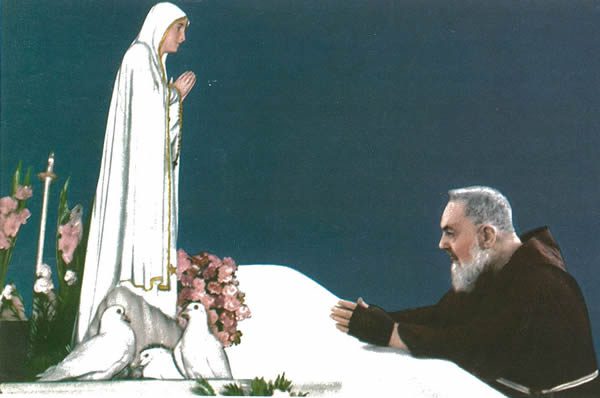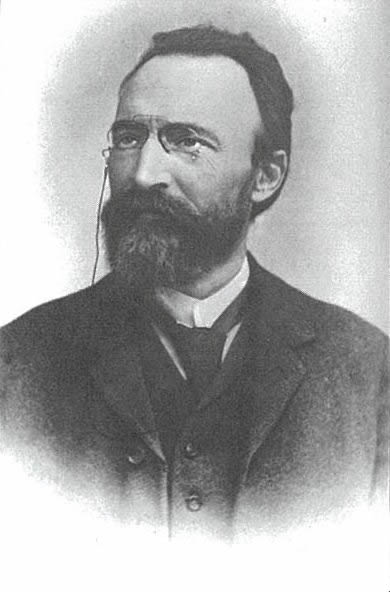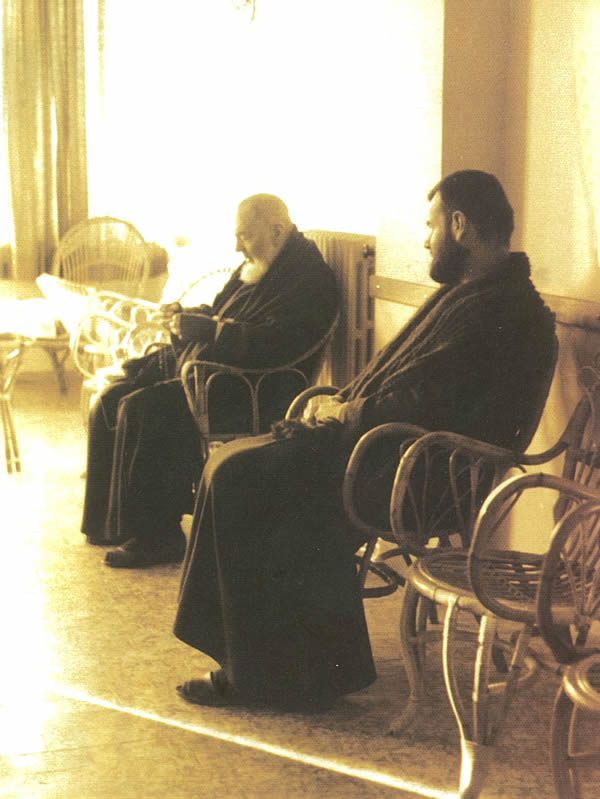Padre Pio’s Holy Death
For many, death is a sorrowful event. For Padre Pio, it was like a release from prison or a long awaited journey home. His life was completely oriented toward attaining Heaven.
– Father Federico de Macchia Valforte
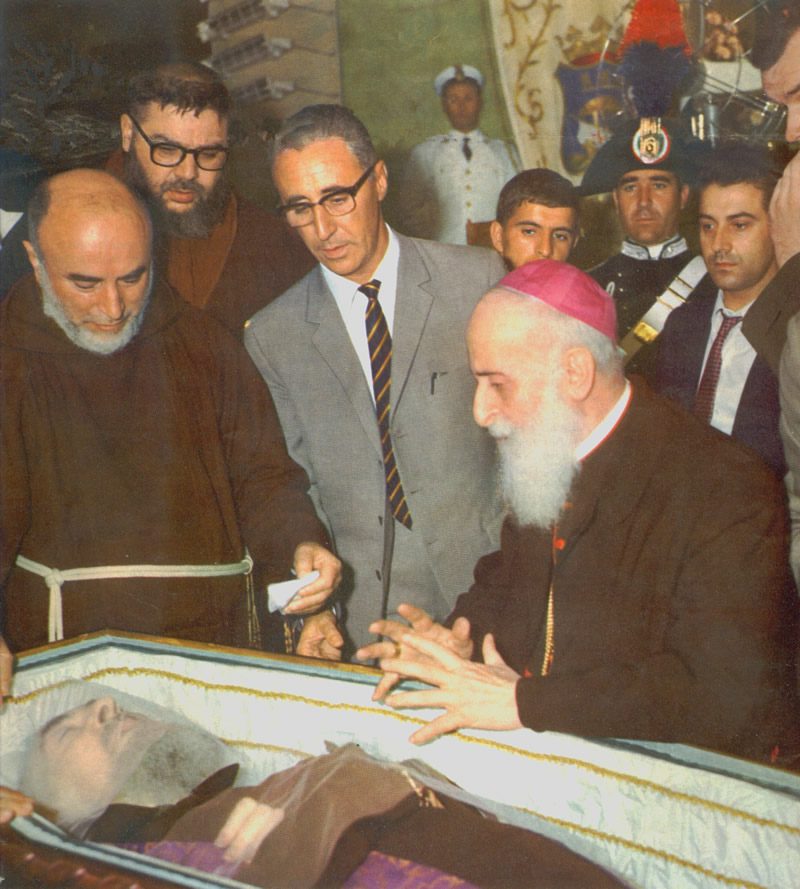
Archbishop Andrea Cesarano stands beside the casket of Padre Pio. The two were very close friends in life. People used to call Archbishop Cesarano, “Padre Pio’s Bishop.”
Padre Pio’s health steadily declined during the last years of his life. In 1968, the year that Padre Pio died, Father Carmelo, the superior of the monastery, was keenly aware of Padre Pio’s deteriorating condition. He told Padre Pio that he did not want him to overtax himself and that he could dispense with hearing confessions if he wanted to. But Padre Pio would not even consider it. He never wanted to ‘retire’ from his priestly ministry. He wanted to work right up until the end and that is exactly what he did. A few days before his death, although weak and extremely ill, he insisted on hearing confessions. ‘He desired to die on his feet, at his place of work, after a day spent with others in prayer and in his ministry for good,’ Father Carmelo said.
The Capuchins who lived with Padre Pio observed the decrease in his physical strength in his later years. On one occasion, Padre Rosario gave Padre Pio a Rosary as a gift. Shortly after, Padre Pio returned it to him. He explained that it was too heavy and he did not have the strength to hold it. Padre Rosario said, ‘He seemed always at the extreme limits of his strength and he was in constant expectation of death.’ When saying goodnight, Padre Pio often asked his Capuchin brothers to recommend him to the Lord because he was not sure if he would be alive in the morning. ‘Padre Pio was not frightened of death, but he felt it looking over his shoulder, ready to snatch him away,’ Padre Rosario said.
Several months before his death, Padre Pio asked that a picture of St. Joseph be hung near his cell. His confreres noticed that he would stop every day before the picture and gaze at it in silence. It was only later that they learned that Padre Pio had been praying each day to St. Joseph for a happy death.
Some of the Capuchins also stated that for a number of weeks before Padre Pio’s death, the monastery of Our Lady of Grace seemed to have an altogether different feeling about it. The corridors, the rooms and gathering areas, and the monastery itself seemed to be pervaded by what was described as a ‘mystical silence.’ At that time, no one knew that Padre Pio would soon be passing away.
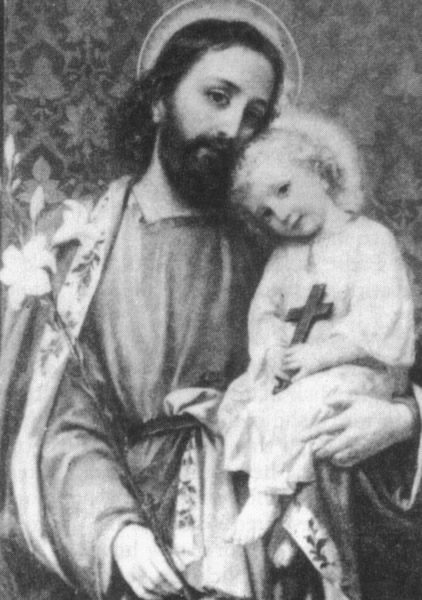
The painting of St. Joseph that Padre Pio prayed before during the last months of his life.
When Padre Pio knew that his end was approaching, he immersed himself in prayer. One of his spiritual sons said, ‘Padre Pio’s life was dedicated to prayer, from the solitary prayers he learned as a child in Pietrelcina, to the Our Father which he prayed in his cell during the last hours of his life, when he was perfectly conscious of his imminent departure. In his temptations he prayed, in his joys he prayed, in the many vicissitudes of life he prayed, in his illness he prayed. God imbued his whole existence and his every action with prayer.’
In a sense, Padre Pio had always looked forward to the end of his earthly pilgrimage. He longed to return to his true home, Heaven, where he could be united to God for eternity. He wrote a letter to Padre Agostino and said:
Living here below is wearisome to me, my dear Father. It is such a bitter torment to me to live in exile that I can hardly go on any longer. The thought that at any moment I could lose Jesus terrifies me in a way I cannot explain. (Letters I)
Not long before Padre Pio passed away, he spoke to Brother Modestino Fucci and asked him to assist him with his prayers. ‘But Spiritual Father,’ Brother Modestino said, ‘it is you who must pray for me.’ Padre Pio answered him, ‘My son, I tell you that the justice of God is severe. Pray for me.’ Brother Modestino understood then that Padre Pio was speaking of his death. Padre Pio also spoke about his death to his friend, Carlo Trabucco. He said to Carlo, ‘When my time comes to leave this life, if my heavenly Mother is not there to hold my hand, how will I have courage?’ Carlo then began to contemplate the thought of his own death, knowing that he too, would have to render an account to God. As Carlo thought about it, he began to tremble.
There were many indications that Padre Pio had knowledge of the time and date of his death. To his niece, Pia Forgione Pennelli, he said in 1966, ‘I will not be alive in two years.’ He would die in 1968. He told his friend Pietruccio Cugino that he would die in his eighty-first year, and indeed he did.
Padre Pio was very close to Father Onorato Marcucci, who assisted him in the last three years of his life. When Father Onorato had to travel to Montecatini a short time before Padre Pio’s passing, Padre Pio said to him, ‘Son, I beg you to return as soon as possible!’ He wanted to have those he loved near him at the time of his death.
Padre Pio told his spiritual daughter, Josephine Bove, that he would die when the crypt in the church of Our Lady of Grace was built. He knew that the Capuchins were planning to build a crypt for his burial. Nevertheless, he indicated that it was not his desire to be buried in a specially made crypt. Rather, he wanted to be buried in a simple grave. The construction of the new church of Our Lady of Grace was finished in 1959. Josephine Bove was afraid that the completion of the new church might in some way be a signal of Padre Pio’s death. But the building of Padre Pio’s crypt was put on hold for a number of years. It was finally completed and was blessed on September 22, 1968. Padre Pio died sixteen hours later.
Shortly before his death, Padre Pio conveyed the message that he would soon be entering eternal life to a number of his spiritual children. One was a woman who lived in Catania, Sicily. She visited San Giovanni Rotondo on September 8, 1968 and made her confession to Father Alberto D’Apolito. She asked Father Alberto for a favor. She told him that she had a great desire to see Padre Pio, even if only for a moment and to kiss his hand. Father Alberto told her that it would be impossible. There were too many pilgrims in the church that day. However, he could arrange for her to see Padre Pio on the following day.
The woman explained to Father Alberto that she had made the long journey to San Giovanni Rotondo from Sicily. She was poor and had made great sacrifices to get to the monastery. She did not have enough money to stay overnight in a hotel but would have to return to Sicily that very day. All of her life, she had wanted to see Padre Pio but could never afford to make the trip. A few days before, she had a vivid dream. In her dream Padre Pio said to her, ‘If you want to see me, come to San Giovanni Rotondo immediately because in a few days I will die.’ She had to borrow the money for the travel expenses.
Father Alberto was skeptical about the woman’s words. He believed that she was making up the story for her own purposes. He heard the same type of requests day in and day out and the more desperate the people were, the more they tended to exaggerate the truth. He had no indication that Padre Pio was going to die any time soon. When the woman began to cry, Father Alberto’s heart softened and he decided to help her. He led her through a corridor of the monastery to the elevator and told her to wait there. Padre Pio would be coming that way shortly. The woman knelt down and waited. When Padre Pio passed by the area where she was kneeling, he stopped. He looked at her with great tenderness and spoke to her. She was deeply moved when he placed his hands on her head, giving her a blessing. Before leaving the monastery, she returned to the confessional to speak to Father Alberto. With tears in her eyes, she thanked him with all her heart for arranging the meeting. It was just fifteen days later that Padre Pio passed away.
September 20, 1968 was the 50th anniversary of Padre Pio’s stigmata. For Padre Pio, it would be a day like any other day, a day devoted to Mass, prayer, and service to the Lord. But it was not a day like any other day for his spiritual children from around the world. Many had come great distances to be present for his anniversary. The Mass on September 20th was at the usual early morning hour of 5:00 a.m. and the church was filled to capacity. Many people had to stand outside during the Mass. In keeping with Padre Pio’s wishes, there were no speeches, no festivities, no celebration. There was only one exception to the rule and that was the hundreds of deep red roses that decorated the sanctuary of the church. The crucifix in the choir loft before which Padre Pio received the stigmata on September 20, 1918, was also adorned with beautiful red roses.
Father Armand Dasseville, OFM Capuchin, was one of the many pilgrims that day who attended the Mass that commemorated the 50th anniversary of Padre Pio’s stigmata. An active promoter of Padre Pio prayer groups in the United States, Father Dasseville had traveled from New York City to attend the Mass. Father Dasseville said:
It is hard to put my impressions of Padre Pio’s Mass into words. All I had heard and read about his masses were true. I was touched by the humility, the sincerity, and the great faith of this man of prayer. He seemed oblivious to the noises and exclamations, the pushing and shoving that was going on in the church as people edged closer to get a better look at him. He literally lived the Mass. He relived the Passion of Christ. From the expression on his face, he actually suffered with Christ. As far as I could judge, the sufferings of Padre Pio were greatest at the moment of the consecration of the Mass. His eyes sometimes would close, his face would contort in pain, and his lips would tremble. Frequently I saw him wipe tears from his eyes with his handkerchief. He was seated for the Mass and faced the people. In obedience to his superiors, the Mass lasted only a good half hour.
Like Father Armand, Dorothy Boes was another one of Padre Pio’s spiritual children who attended the Mass on September 20. Dorothy had always had a great desire to visit Padre Pio and when she heard that there would be a Mass at Our Lady of Grace monastery celebrating the 50th anniversary of Padre Pio’s stigmata, she immediately applied for a passport to travel to Italy. She received it just in time. Dorothy and her friend Mary arrived in San Giovanni Rotondo on September 19. Knowing how crowded the Mass would be the next morning, they decided to get to the church at 2:30 a.m. to wait for the doors to open. When the church finally opened, the two women were almost knocked down by the crowds who rushed in all at once. Nevertheless, Dorothy and Mary managed to find good seats in the front.
Afterwards, Mary and Dorothy along with some of the other pilgrims in attendance were taken to a room in the monastery where Padre Pio was brought in to greet them. Dorothy said, ‘Padre Pio looked directly at Mary and I and said, ‘I knew for a long time that all of you would be coming to see me.’ Then he called us his children.’ Shortly after, Dorothy and Mary left San Giovanni Rotondo to return home. Just a few days later they learned that Padre Pio had passed away.
Mr. Gino Pin and his family also came to attend the 50th anniversary Mass of Padre Pio’s stigmata. Gino had a great devotion to Padre Pio and was a tireless worker for the Padre Pio prayer groups in Biella, Italy. Father Alberto D’Apolito was very happy to greet Gino when he arrived. He felt sorry for Gino because he knew that he had experienced many difficulties in his family life. Padre Alberto went to Padre Pio with a request. He handed him a holy card and asked him to write a devotional message on the back. He did not tell him who he was going to give it to. He knew how much it would mean to Gino to have a prayer card that Padre Pio had inscribed. Padre Pio kissed the holy card and blessed it and wrote on the back, ‘May Jesus and Mary always sweeten your sorrows.’ When Father Alberto read the message, he was disappointed. He did not want Gino to be reminded of his ‘sorrows’ for he had experienced one trial after another in recent years. He decided not to give the holy card to Gino.
Instead, Father Alberto arranged for Gino to see Padre Pio personally. He took him to the veranda of the monastery so that he could greet Padre Pio. Padre Pio spoke to him with affection and said he would pray for his intentions. Before Gino left, Padre Pio gave him a blessing.
Afterward, Father Alberto decided to give Gino the holy card that Padre Pio had signed. Gino read the message on the back of the card and his eyes filled with tears. He said to Father Alberto, ‘Did you see the message that Padre Pio wrote to me?’ indicating the reference to his ‘sorrows.’ Father Alberto encouraged Gino by saying, ‘Be strong. Padre Pio is with you. He will help you.’ Later that evening, Gino came back to the monastery to see Father Alberto. He was crying as he told Father Alberto that his daughter, Maria Pia, had just been admitted to the hospital and was in very serious condition. The doctors suspected that she had a tumor or possibly peritonitis.
The next morning, Maria Pia’s condition was even more desperate. Gino wondered if he should take her back home to Biella to receive medical treatment there. He asked Father Alberto to explain the situation to Padre Pio and ask for his advice. Father Alberto went at once to look for Padre Pio and found him on the veranda, praying the Rosary. Father Alberto spoke to him about Gino, but he did not reply. It did not seem as though he was even aware of Father Alberto’s presence, for he was deeply immersed in prayer.
Father Alberto finally tapped Padre Pio to get his attention and he then looked up in surprise. ‘Padre Pio,’ Father Alberto said. ‘Gino’s daughter, Maria Pia, is in the hospital in very serious condition. She may need an operation. Gino needs your advice. He wonders if he should take her back home to Biella. What should he do?’ ‘She should not be moved from the hospital,’ Padre Pio replied. ‘If she needs an operation, she should be operated on here and not in Biella.’ ‘Gino is a poor man,’ Father Alberto said. ‘He cannot afford to have his daughter remain in the hospital and he cannot afford the cost of an operation. Can’t you invoke a cure from the Blessed Virgin for Maria Pia so that she doesn’t have to have an operation?’ ‘Yes, I will pray about it,’ Padre Pio answered.
Several hours later when Dr. Gusso, the head physician of the Home for the Relief of Suffering examined Maria Pia, he found that she was completely well. She was immediately discharged from the hospital. The miraculous recovery of Gino Pin’s daughter occurred on September 22, one day before Padre Pio’s death. It is considered to be possibly the last miracle, the last grace invoked by Padre Pio to the Blessed Virgin, before he died.
Marissa Liberati, a spiritual daughter of Padre Pio, used to travel from Rome to San Giovanni Rotondo twice a month to make her confession to Padre Pio. She told him that she would like to bring her two nieces, Lucia and Anna to the monastery to receive their first Holy Communion from his hands. Padre Pio told her to have the girls receive their religious instruction in Rome and when it was completed he would be happy to give them their first Communion. Lucia and Anna attended catechism classes and completed their sacramental preparation but their parents kept delaying the date for the trip to San Giovanni Rotondo. Marissa frequently spoke to Padre Pio about the situation.
Toward the middle of September 1968, Marissa had a vivid dream. In her dream, Padre Pio told her to bring Anna and Lucia to San Giovanni Rotondo as soon as possible. There was an urgency in his words. When she woke up, she reflected on the dream and decided to cancel the pilgrimage that she was planning to make to Lourdes. Instead, she purchased the first Holy Communion clothing for her nieces and along with their mother, took the girls to San Giovanni Rotondo.
Padre Pio was extremely weak and ill on the day that Marissa arrived with her nieces and their mother. It was September 22 and the church was full to overflowing. The members of Padre Pio’s worldwide prayer groups were present at the Mass that morning. They had come to San Giovanni Rotondo to attend the International Prayer Group Congress. Padre Pio said Mass on that day in thanksgiving for the prayer groups and in special thanksgiving for the official approval and recognition they had recently received from the Holy Office in Rome. It was a great joy for Padre Pio to know that his prayer groups were established on a firm foundation and were flourishing worldwide.
At the Mass, Padre Pio gave Communion first to Lucia and then to Anna. Anna Fanoni was the last person to receive Holy Communion from Padre Pio’s hands for he died the very next day. As he left the altar, he almost collapsed. Several of the Capuchins who assisted at the Mass aided him and kept him from falling. Padre Pio looked out at the sea of people, and in a broken and shaky voice called out, ‘My children, my children.’ Later, he went to a window of the monastery to greet and bless the prayer group members who were gathered in the piazza below. He was so weak that he had to be supported by two of his brother Capuchins.
That evening about 9:00 p.m. Padre Pio used the intercom to call Padre Pellegrino to come to his room. Padre Pellegrino, who took turns with Padre Onorato and Padre Mariano in assisting Padre Pio, was assigned to the evening duty that night. When Padre Pellegrino answered Padre Pio’s call and entered his room, he found him in bed and noticed that his eyes were red with tears. Padre Pio had called him because he wanted to know what time it was. Padre Pellegrino dried Padre Pio’s tears with a handkerchief and told him the time. After he checked to make sure that Padre Pio was all right, he went back to his room.
During the evening, Padre Pio called Padre Pellegrino to his room five or six times asking for small necessities. Every time he entered the room, he noticed tears in Padre Pio’s eyes. Nevertheless, Padre Pio joked with him by calling him Don Pellegrino rather than the usual, ‘my son’ or ‘my brother.’ He always called him Don Pellegrino whenever wanted to make him laugh.
Around midnight, Padre Pio asked Padre Pellegrino if he would stay on in his room with him, and he was happy to do so. Usually Padre Pellegrino sat in the armchair but on this night, Padre Pio wanted him to sit right beside his bed. He took Padre Pellegrino’s hand in his and held it tightly. Padre Pio began to tremble like a frightened child. Every few minutes he wanted to know the time. Padre Pellegrino did not know what to make of it. It almost seemed as though he had an appointment with someone. He continued to wipe the tears from Padre Pio’s eyes and to stay close beside him.
A little after midnight, Padre Pio asked Padre Pellegrino if he had celebrated Mass. ‘Spiritual Father, it is too early to say Mass,’ Padre Pellegrino answered. ‘Today you will celebrate the Mass for me,’ Padre Pio said. Padre Pellegrino did not understand Padre Pio’s words and replied, ‘But I say Mass every day for your intentions.’ ‘Today you will say Mass for my soul,’ Padre Pio said. The words sounded strange to Padre Pellegrino but he did not ask for an explanation.
He then asked Padre Pellegrino to hear his confession. Padre Pellegrino was not his regular confessor but he had heard his confession many times in the past and he heard it on this night. ‘If the Lord calls me today, ask the Brothers to forgive me for all the trouble I have been to them and ask them and all my spiritual children to pray for my soul,’ Padre Pio said. Padre Pellegrino assured him that he had no need to worry for he still had a long time yet to live. Nevertheless, Padre Pellegrino added, ‘But if it is indeed near the time of your death, I ask you for a last blessing for the Brothers and for all of your spiritual children.’ Padre Pio answered, ‘I bless them all and I ask you to have the superior give them this last blessing for me.’
Padre Pio then said that he wanted to renew his religious vows. At these words, Padre Pellegrino grew frightened because in the Capuchin tradition, the only time the vows of religious profession are renewed is when one is on his death bed. Padre Pio was putting everything in order, down to the last detail. Padre Pellegrino listened as Padre Pio renewed his vows of poverty, chastity and obedience. Padre Pio said:
I, Padre Pio of Pietrelcina, vow and promise to Almighty God, to the Blessed Virgin Mary, to our Holy Father, Saint Francis, to all the saints and to you, Father, to observe all the days of my life, the Rule of the Friars Minor, confirmed by Pope Honorius, and to live in obedience, without property, and in chastity.
Padre Pellegrino spoke the response, ‘If you abide by this, on behalf of God, I promise you eternal life.’ Padre Pio said that he could not breathe well in bed and wanted to get up. ‘Are there any stars in the sky tonight?’ Padre Pio asked. ‘Yes, indeed. The sky is studded with stars tonight,’ Padre Pellegrino replied. ‘Let us go to the veranda then and see,’ Padre Pio said. Padre Pio had severe arthritis and at eighty-one years of age, his posture was stooped and bent. Because it was very painful for him to walk, he used a wheelchair most of the time. But on this night for some reason, he was able to stand up straight and he walked briskly and with great ease, to the veranda, needing no assistance. To Padre Pellegrino, he suddenly looked twenty years younger.
When Padre Pio got to the veranda, he reached over and turned on the light. That was something he had not done in so long that Padre Pellegrino could not even remember. He knew from personal experience that unusual things often happened in Padre Pio’s presence and he reasoned that this night was no exception. Padre Pio then began to stare intently at a particular area on the veranda. Padre Pellegrino could not understand what he was looking at with such concentration, but soon he would understand. He was staring at the exact place where the Capuchins would carry his lifeless body in just a few short hours.
Suddenly Padre Pio began to feel very ill. He wanted to go back to his room but he was too weak to stand up. Padre Pellegrino quickly went to get a wheelchair. Meanwhile, all of the color had drained out of Padre Pio’s face and he was growing weaker by the minute. He began to repeat the words, Jesus . . . Mary . . . over and over. All the while, his voice was growing fainter.
Padre Pellegrino took him back to his room in the wheelchair but had great difficulty getting him into his armchair. Once he finally got him settled, Padre Pio began to stare intently at a picture that was hanging on the wall. He wanted to know who it was. Padre Pellegrino answered, ‘Those are photographs of your mother and father.’ ‘But I see two mothers,’ Padre Pio said. ‘No, there is only one mother there,’ Padre Pellegrino replied, pointing to Giuseppa Forgione. ‘Don’t worry,’ Padre Pio said, ‘I can see very well but I can see two mothers.’
Padre Pellegrino had lived with Padre Pio for a long time. He knew that Jesus and the Virgin Mary often appeared to him. Padre Pio also had the rare gift of being able to see his guardian angel in form. Many times, when he was in prayer, he seemed to be having a conversation with someone, someone that he could see but that no one else could see. Padre Pellegrino was convinced that the Virgin Mary was present in his room at that moment and that Padre Pio could see her.
Right after Padre Pio spoke of seeing ‘two mothers’ he seemed to grow weaker. He broke out into a cold sweat and his lips began to turn blue. Padre Pellegrino became alarmed and started to go to get assistance. ‘I do not want you to disturb anyone,’ Padre Pio told him. ‘Do not waken anyone.’ But Padre Pellegrino insisted on getting help and quickly left the room. He woke up Brother Bill Martin and told him to place a call to Dr. Giuseppe Sala immediately. After that, Padre Pellegrino woke up all the other Capuchins and told them to hurry to Padre Pio’s cell. Dr. Sala arrived in less than ten minutes and realized that Padre Pio was having a severe bronchial asthma attack. He gave him an injection as well as oxygen in an attempt to ease his breathing which had become difficult and labored.
By that time, Father Mariano, Brother Bill Martin, Father Carmelo and the other Capuchins had gathered in Padre Pio’s room. Dr. Giovanni Scarale and Dr. Giuseppe Gusso soon arrived as well as Mario Pennelli, Padre Pio’s nephew. While the doctors were doing their very best to help Padre Pio, the Capuchins knelt down beside him and prayed the Our Father, the Hail Mary, the prayer for a holy death, and the prayer to St. Joseph, patron of the dying. Together, the Capuchins repeated, ‘Jesus, Mary and Joseph, I give you my heart and my soul. Jesus, Mary and Joseph, assist me in my last agony. Jesus, Mary and Joseph, may my soul peacefully expire in You.’
The Holy Oils were prepared and Father Paolo gave Padre Pio the Last Rites. Padre Pio was fully conscious and was very much aware of all that was happening. His feet and hands were becoming very cold and he was perspiring heavily. When the doctors realized that he was having a heart attack, he was given an injection directly into his heart. With his eyes closed, he continued to repeat the words, Jesus . . . Mary . . . Toward the end, his lips formed the words but he could make no sound, not even a whisper. The Capuchins called out to him, ‘Padre, Padre!’ He opened his eyes one last time and looked at his dear Brothers. At 2:30 a.m. with his Rosary clasped in his hands, Padre Pio gently bowed his head and died. Dr. Gusso, who had been present during Padre Pio’s final moments, stated that it was the most gentle and beautiful passing that he had ever witnessed. Padre Pio had lived a holy life and he had died a holy death.
During the months that preceded his death, Padre Pio’s stigmata had been slowly disappearing, beginning with the wounds on his feet. The Capuchins who attended him noticed that his wounds were bleeding less and less. The bandages that had to be changed regularly were significantly less bloodstained. On September 22, 1968, the day before Padre Pio’s death, his left palm still had a raised scab. During the Mass that morning, two scales fell from his hand.
When Dr. Sala and Father Carmelo examined Padre Pio’s body after his death, they discovered that the stigmata on his hands, feet, and side had disappeared completely. His skin was now smooth and regenerated in the places where the wounds had once been. There was no scarring whatsoever. The skin looked as fresh as that of a newborn baby. Dr. Sala noticed the beautiful fragrance of orange blossoms in the room. He had perceived the fragrance on many occasions when in the presence of Padre Pio. As the two stood together and looked at Padre Pio’s lifeless body, a scab detached and fell from his left hand. It was the very last sign of the wounds of Christ which he had carried on his body for fifty years.
The news of Padre Pio’s death spread quickly. No one had anticipated it or had any reason to expect that he would die on September 23. The world was shocked and in mourning. In his hometown of Pietrelcina, the bells of the parish church tolled every half-hour.
Many who had come to attend Padre Pio’s 50th Anniversary Mass as well as the International Prayer Group Congress, were present at his funeral. It was as if Divine Providence had arranged for Padre Pio’s spiritual children from all parts of the world to be nearby at the time of his passing.
Padre Pio looked beautiful and serene in death. A Rosary was placed in his hands as well as a crucifix and the Rule of Saint Francis. Around his shoulders was draped his priestly purple stole. Before the funeral began, the casket that contained Padre Pio’s body was placed in an open hearse. Slowly and solemnly it made its way through the narrow streets of San Giovanni Rotondo, stopping in front of the Home for the Relief of Suffering for a last salute. The funeral procession took more than three hours. Air force and police helicopters flew overhead, dropping flowers and prayer cards on the huge crowd below. It is estimated that one hundred thousand people attended Padre Pio’s funeral Mass. His body was placed in a granite crypt and buried directly below the main altar of the church.
Padre Pio assured his spiritual children that his death would not end their bond but that he would be ever ready to intercede and to help them from Heaven. On one occasion, Father Costantino Capobianco told Padre Pio that he hoped that he would die before Padre Pio did. ‘Why is that?’ Padre Pio asked. ‘It is because I would like you to be with me to assist me at the time of my death,’ Father Costantino replied. ‘But don’t you know that I can help you from Heaven?’ Padre Pio replied.
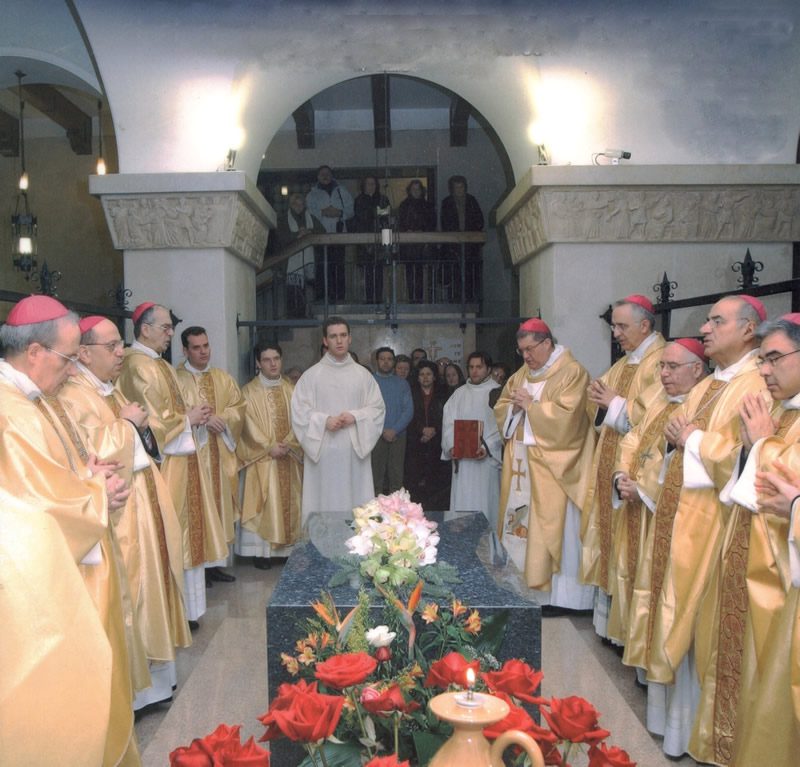
Bishops gather in San Giovanni Rotondo to pray at the tomb of Padre Pio.
The stories that attest to Padre’s intercession since his passing are too numerous to count. One impressive testimony concerns a woman named Constance Woloskiuk who turned on her television set on September 23, 1968. She learned the news that Padre Pio has passed away that very morning and saw the crowds of people in San Giovanni Rotondo, all gathered to pay their last respects. Constance had been suffering for a long time from a very painful lower back condition. As she listened to the report of Padre Pio’s death on her television set, she sent up a heartfelt prayer to him, asking for healing. Immediately, she noticed that all the pain in her lower back had vanished. Almost in disbelief, she kept getting up out of the chair and sitting back down again. That was something that previously, she could only do with great difficulty. It was a true miracle.
Another remarkable testimony concerns Mrs. Roversi who, along with her husband, owned a religious goods shop near the monastery of Our Lady of Grace. In addition to the rosaries and medals which were sold in their shop, literature about Padre Pio was also available, as well as his photographs and prayer cards.
When her husband passed away, Mrs. Roversi was put in a difficult situation. She needed an income to support her two children but had no knowledge of how to run the store. Her husband had always handled all aspects of the business. Mrs. Roversi went to Padre Pio’s tomb and prayed, ‘Padre Pio, I do not know how to manage the business. I need to support my children and I pray for your intercession. I need your help!’ Immediately after the prayer, she felt a deep sense of peace and was greatly strengthened in spirit.
That night Mrs. Roversi had a dream in which she saw Padre Pio standing in front of her. He said, ‘Look, I can help you now much more than I could when I was on earth.’ His hands were open and she saw that he no longer had the stigmata. In her dream, she said to him, ‘I know nothing about running the store and I am afraid that I will not be able to do it.’ Padre Pio said to her, ‘Go forward with it. I will help you.’ He showed her his hands and for the second time she saw that the wounds of the stigmata were gone. Then she woke up. Mrs. Roversi acted upon the advice that Padre Pio had given her in the dream. She learned how to manage the store and everything went smoothly from that time on. The business did well and she was able to provide for her two children.
Once, a sick man who knelt at the tomb of Padre Pio, prayed for healing. He rose from his knees to find that he had been miraculously cured. He noticed a tiny rose petal on the top of the tomb and took it home to a friend. She too was healed.
‘I will be able to help you more from Heaven that I can on earth,’ Padre Pio often said to those who sought his counsel. And it is from Heaven that he has been helping so many of his spiritual children from every part of the world.
______________________________
For to me, to live is Christ and to die is gain.
– Philippians 1:21
Padre Pio Devotions Books by Diane Allen
1. Pray, Hope and Don’t Worry: True Stories of Padre Pio Book 1
2. Pray, Hope and Don’t Worry: True Stories of Padre Pio Book II
3. Daily Reflection: 365 Reflections from the Saints and Other Holy Men and Women of God
4. They Walked with God Book 1: St. Bernadette Soubirous, St. John Vianney, St. Damien of Molokai, St. André Bessette, Bl. Solanus Casey
5. They Walked with God Book 2: St. Teresa of Calcutta, St. Maximilian Maria Kolbe, St. John Bosco






